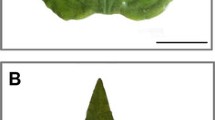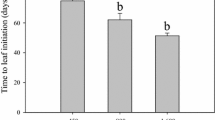Abstract.
Kalanchoë pinnata (Lam.) Pers. (Crassulaceae), a succulent-leaved crassulacean-acid-metabolism plant, was grown in open-top chambers at ambient and elevated (two times ambient) CO2 concentrations under natural conditions at the Smithsonian Tropical Research Institute, Republic of Panama. Nocturnal increase in titratable acidity and nocturnal carbon gain were linearly related, increased with leaf age, and were unaffected by CO2 treatments. However, under elevated CO2, dry matter accumulation increased by 42–51%. Thus, the increased growth at elevated CO2 was attributable entirely to increased net CO2 uptake during daytime in the light. Malic acid was the major organic acid accumulated overnight. Nocturnal malate accumulation exceeded nocturnal citrate accumulation by six-to eightfold at both CO2 concentrations. Basal (predawn) starch levels were higher in leaves of plants grown at elevated CO2 but diurnal fluctuations of starch were of similar magnitude under both ambient and elevated CO2. In both treatments, nocturnal starch degradation accounted for between 78 and 89% of the nocturnal accumulation of malate and citrate. Glucose, fructose, and sucrose were not found to exhibit marked day-night fluctuations.
Similar content being viewed by others
Author information
Authors and Affiliations
Additional information
Received: 4 March 1996 / Accepted: 25 May 1996
Rights and permissions
About this article
Cite this article
Winter, K., Richter, A., Engelbrecht, B. et al. Effect of elevated CO2 on growth and crassulacean-acid-metabolism activity of Kalanchoë pinnata under tropical conditions. Planta 201, 389–396 (1997). https://doi.org/10.1007/s004250050081
Issue Date:
DOI: https://doi.org/10.1007/s004250050081




